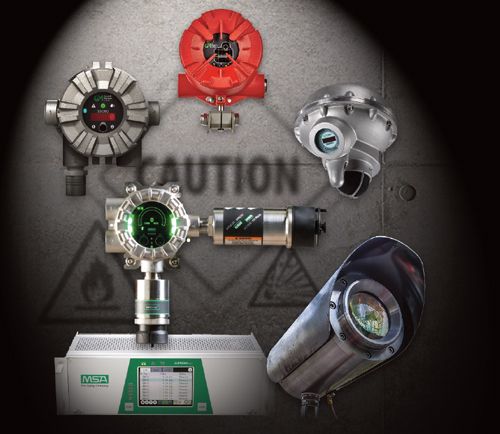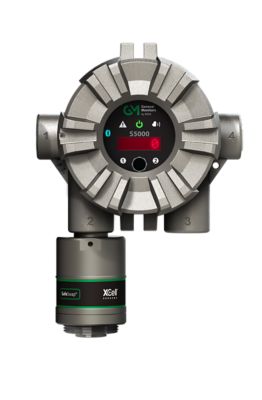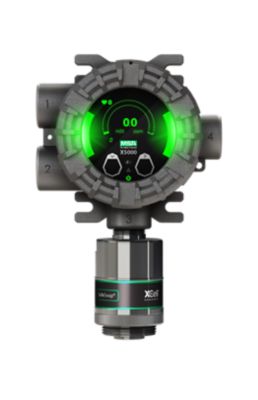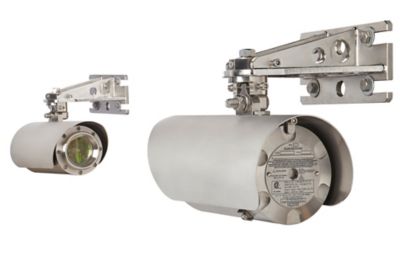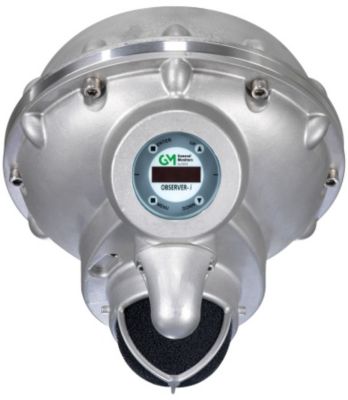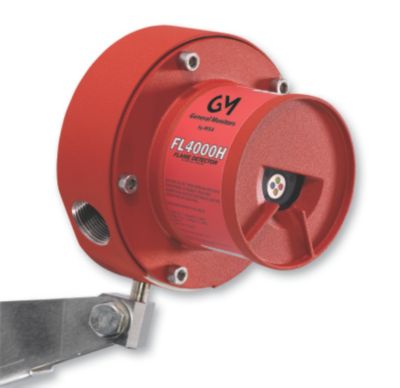Gas leak detector systems keeping LNG facilities safe
Increasing operational efficiency of LNG facilities with innovative gas detection technologies.
Demands for cleaner fuels such as natural gas continue to grow and the development of efficient new liquefied natural gas (LNG) facilities and infrastructure grows accordingly. MSA has considerable experience of providing tailored gas detector and gas monitor systems to ensure that LNG facilities remain safe and operating efficiently.
Contact MSA Today What's New in LNGNatural gas is the cleanest-burning of all fuels.
Don't compromise on safety while taking the advantage of this energy source.
Click on the image below to explore MSA’s extensive fixed gas and flame detection solutions for the LNG supply chain.
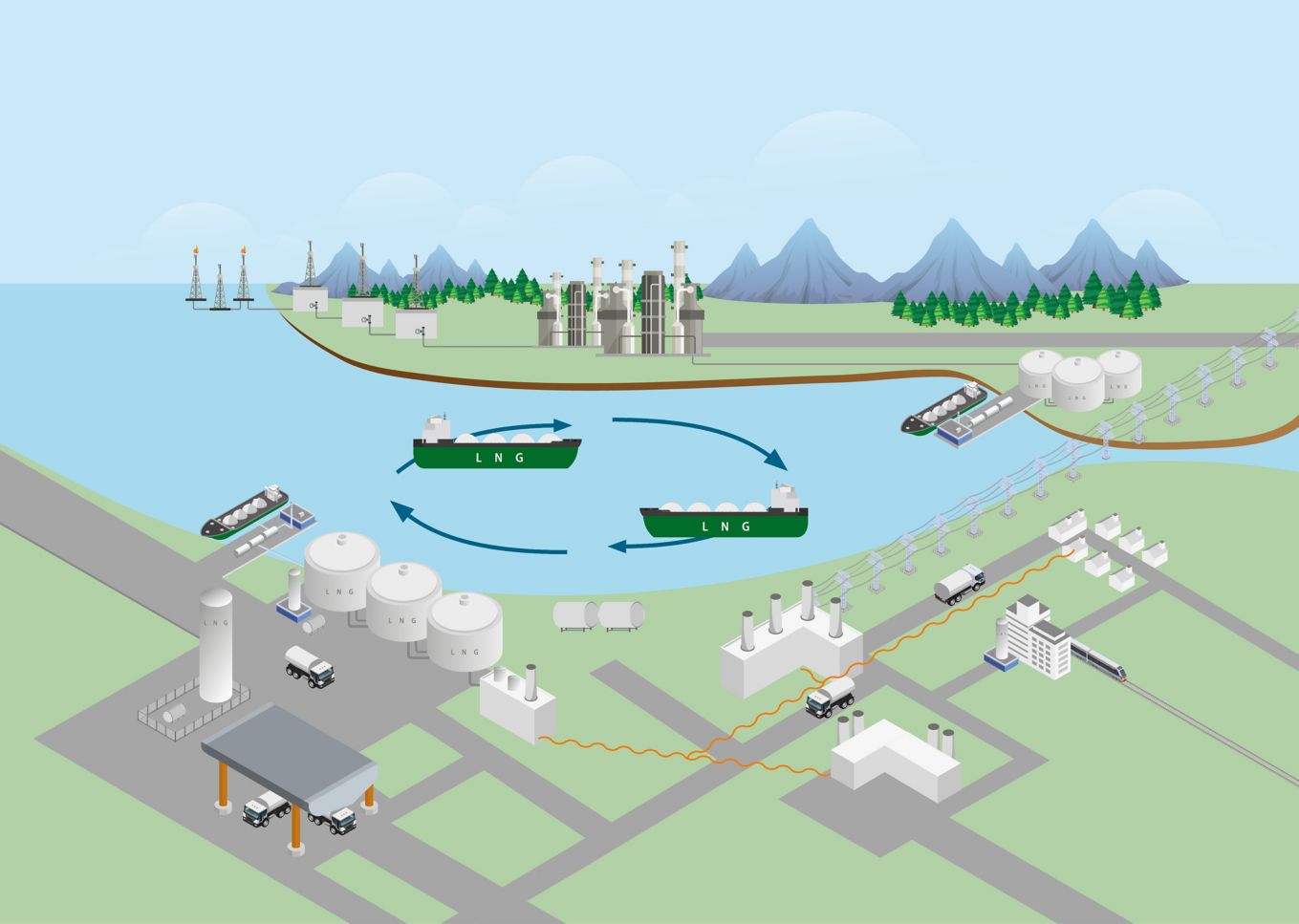
Discover Why
Growing natural gas market requires reliable deployment of fire and gas detectors that maximize detection efficiency.
Moving beyond traditional gas detection technologies will decrease your cost of ownership allowing to reach your targets while increasing protection from undetected gas leaks.
Consult with MSA TodayProduction
Extraction of the natural gas is the first step along the process chain. At this point gas contains variety of other compounds and gases which must be removed. Their presence poses the risk of explosions but also toxic environment with H2S as one example. They have to be monitored with various sensing technologies resistant to harsh environment.
The General Monitor S5000 Gas Detector is designed for the extreme conditions and uses diverse sensing technologies for the detection of combustible and toxic gases.
View application detailsTreatment & Liquefaction Plant
The natural gas is sent to a treatment & liquefaction plant, for removal of various impurities such as mercury, sulphur compounds or carbon dioxide. “Train” installations are used to treat & liquefy natural gas at the facility. They are monitored for treated natural gas and refrigerant leaks.
The ULTIMA® X5000 GasDetector employs diverse sensing technologies for the detection of combustible and toxic gases.
View application detailsLNG Carrier
When LNG is to be transported at greater distance, it is shipped by sea in specialized LNG ships. Safety systems on LNG carriers include gas detectors arranged at points where gas is expected to gather or zones where air circulation is reduced.
The ULTIMA® X5000 Gas Detector employs diverse sensing technologies for the detection of combustible and toxic gases.
View application detailsReceiving Terminal
Dock unloading areas and storage tanks are crucial components of terminal and should be closely monitored for gas leakages. Due to large areas to cover, open path gas detection for perimeter monitoring is one of the key technology, assisting with performance and operation efficiency.
The Senscient ELDS™ Open Path Gas Detector provides best in class false alarm rejection in monitoring flammable gases.
View application detailsRegasification
LNG must be turned back into a gas for further use and this is done at regasification facility. This can be receiving terminal, offshore terminals which are LNG ships functioning as Floating Storage and Regasification Units (FSRU) or any plant that receives LNG which is used later in regasified form. Such operations have to be supervised by gas leak detection systems.
The ULTIMA® X5000 Gas Detector employs diverse sensing technologies for the detection of combustible and toxic gases.
View application detailsFueling Station
The potential gas hazard sources of an LNG filling station are especially storage tank, delivery installation and gas dispensers including the vehicle being refueled. These areas are protected by gas detectors but installed flame detectors help to mitigate the hazards of fires with immediate ignition.
The FL4000H is an advanced Multi-Spectrum Infrared (MSIR) Flame Detector which provides superior false alarm immunity with the widest field of view.
View application detailsCompressor Station
Early detection of dangerous compressed gas leaks is critical to help mitigate the risk of leak and later ignition. Ultrasonic technology greatly supports traditional infrared and catalytic bead gas detectors so that natural gas compressors locations remain safe and explosion-free.
The Observer-i Gas Leak Acoustic Detector utilizes ultrasonic technology, instantly detects pressurized gas leaks with unmatched high-precision.
View application detailsBunkering Terminal
LNG Bunkering is the practice of providing liquefied natural gas fuel to a ship for its own consumption. There are few scenarios for supplying the ships with one that marine vessels arrive at specifically designed terminals which are protected by gas and fire detection during LNG transfer.
The FL4000H is an advanced Multi-Spectrum Infrared (MSIR) Flame Detector which provides superior false alarm immunity with the widest field of view.
View application detailsDistribution
The growth of the global natural gas market with the distribution of LNG to smaller end users, has provided access to natural gas to wide range of energy consumers. The addition of gas leak detection and protection systems, in most these local installations, can help in enforcing the high level of risk mitigation an meeting local safety requirements.
The ULTIMA® X5000 Gas Detector employs diverse sensing technologies for the detection of combustible and toxic gases.
View application detailsPower Plant
LNG is substituting for traditional fuels like heavy fuel oil or diesel also in power plants. These can be located at islanded locations or remote, utilizing gas-fueled power generation systems complemented sometimes by locally available renewable energy. Installed gas and flame detection systems help to keep such strategic facilities safe.
The ULTIMA® X5000 Gas Detector employs diverse sensing technologies for the detection of combustible and toxic gases. View application details
Plants
Many production plants are not located near a natural gas pipeline. This means a greater reliance on fuel sources and increased cost. Therefore manufacturers have found a solution to address these challenges by using LNG to fuel their stationary and temporary production facilities, which also require reliable gas leak detection systems.
The ULTIMA® X5000 Gas Detector employs diverse sensing technologies for the detection of combustible and toxic gases.
View application detailsLoading Terminal
LNG can be transferred from export terminal storage to vessels using pressure, or cryogenic pumps. During this operation where hoses or loading arms are used the risk of gas leak increases and has to be monitored, often over wide area.
The Senscient ELDS™ Open Path Gas Detector provides best in class false alarm rejection in monitoring flammable gases.
View application detailsLNG Carrier
When LNG is to be transported at greater distance, it is shipped by sea in specialized LNG ships. Safety systems on LNG carriers include gas detectors arranged at all points where gas is expected to gather or zones where air circulation is reduced.
The ULTIMA® X5000 Gas Detector employs diverse sensing technologies for the detection of combustible and toxic gases.
View application detailsStorage
Modern technologies offer high quality and safe gas storage with several layers of protection. It is still important to monitor crucial components of storage facility, especially loading and BOG handling installations. Combustible gas detectors respond quickly to gas leaks, reliably protecting the assets.
The ULTIMA® X5000 Gas Detector employs diverse sensing technologies for the detection of combustible and toxic gases.
View application details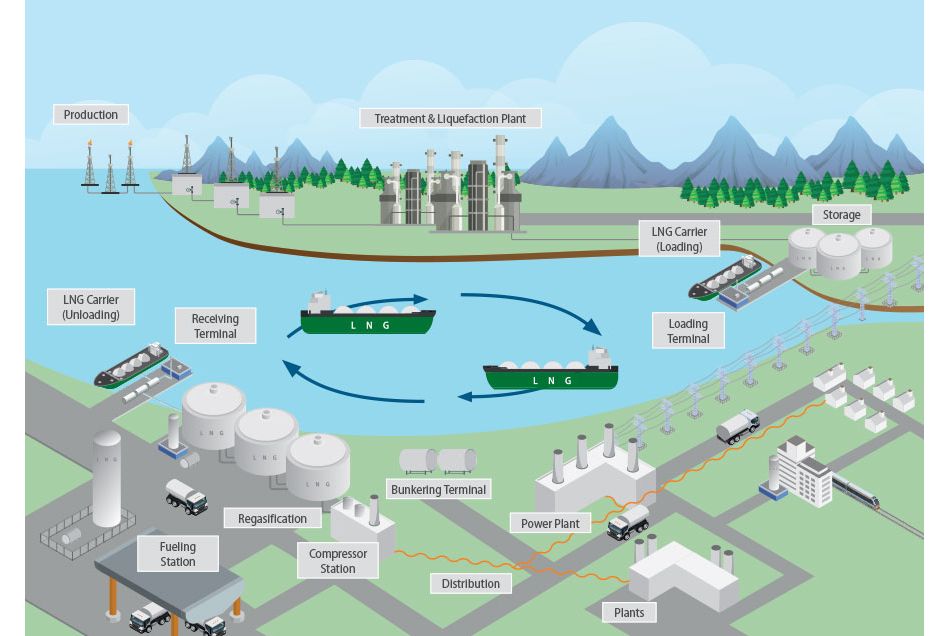
Growing natural gas market requires reliable deployment of fire and gas detectors that maximize detection efficiency.
Moving beyond traditional gas detection technologies will decrease your cost of ownership allowing to reach your targets while increasing protection from undetected gas leaks.
Extraction of the natural gas is the first step along the process chain. At this point gas contains variety of other compounds and gases which must be removed. Their presence poses the risk of explosions but also toxic environment with H2S as one example. They have to be monitored with various sensing technologies resistant to harsh environment.
The General Monitor S5000 Gas Detector is designed for the extreme conditions and uses diverse sensing technologies for the detection of combustible and toxic gases.
View application detailsThe natural gas is sent to a treatment & liquefaction plant, for removal of various impurities such as mercury, sulphur compounds or carbon dioxide. “Train” installations are used to treat & liquefy natural gas at the facility. They are monitored for treated natural gas and refrigerant leaks.
The ULTIMA® X5000 GasDetector employs diverse sensing technologies for the detection of combustible and toxic gases.
View application detailsWhen LNG is to be transported at greater distance, it is shipped by sea in specialized LNG ships. Safety systems on LNG carriers include gas detectors arranged at points where gas is expected to gather or zones where air circulation is reduced.
The ULTIMA® X5000 Gas Detector employs diverse sensing technologies for the detection of combustible and toxic gases.
View application detailsDock unloading areas and storage tanks are crucial components of terminal and should be closely monitored for gas leakages. Due to large areas to cover, open path gas detection for perimeter monitoring is one of the key technology, assisting with performance and operation efficiency.
The Senscient ELDS™ Open Path Gas Detector provides best in class false alarm rejection in monitoring flammable gases.
View application detailsLNG must be turned back into a gas for further use and this is done at regasification facility. This can be receiving terminal, offshore terminals which are LNG ships functioning as Floating Storage and Regasification Units (FSRU) or any plant that receives LNG which is used later in regasified form. Such operations have to be supervised by gas leak detection systems.
The ULTIMA® X5000 Gas Detector employs diverse sensing technologies for the detection of combustible and toxic gases.
View application detailsThe potential gas hazard sources of an LNG filling station are especially storage tank, delivery installation and gas dispensers including the vehicle being refueled. These areas are protected by gas detectors but installed flame detectors help to mitigate the hazards of fires with immediate ignition.
The FL4000H is an advanced Multi-Spectrum Infrared (MSIR) Flame Detector which provides superior false alarm immunity with the widest field of view.
View application detailsEarly detection of dangerous compressed gas leaks is critical to help mitigate the risk of leak and later ignition. Ultrasonic technology greatly supports traditional infrared and catalytic bead gas detectors so that natural gas compressors locations remain safe and explosion-free.
The Observer-i Gas Leak Acoustic Detector utilizes ultrasonic technology, instantly detects pressurized gas leaks with unmatched high-precision.
View application detailsLNG Bunkering is the practice of providing liquefied natural gas fuel to a ship for its own consumption. There are few scenarios for supplying the ships with one that marine vessels arrive at specifically designed terminals which are protected by gas and fire detection during LNG transfer.
The FL4000H is an advanced Multi-Spectrum Infrared (MSIR) Flame Detector which provides superior false alarm immunity with the widest field of view.
View application detailsThe growth of the global natural gas market with the distribution of LNG to smaller end users, has provided access to natural gas to wide range of energy consumers. The addition of gas leak detection and protection systems, in most these local installations, can help in enforcing the high level of risk mitigation an meeting local safety requirements.
The ULTIMA® X5000 Gas Detector employs diverse sensing technologies for the detection of combustible and toxic gases.
View application detailsLNG is substituting for traditional fuels like heavy fuel oil or diesel also in power plants. These can be located at islanded locations or remote, utilizing gas-fueled power generation systems complemented sometimes by locally available renewable energy.. Installed gas and flame detection systems help to keep such strategic facilities safe.
The ULTIMA® X5000 Gas Detector employs diverse sensing technologies for the detection of combustible and toxic gases. View application details
Many production plants are not located near a natural gas pipeline. This means a greater reliance on fuel sources and increased cost. Therefore manufacturers have found a solution to address these challenges by using LNG to fuel their stationary and temporary production facilities, which also require reliable gas leak detection systems.
The ULTIMA® X5000 Gas Detector employs diverse sensing technologies for the detection of combustible and toxic gases.
View application detailsLNG can be transferred from export terminal storage to vessels using pressure, or cryogenic pumps. During this operation where hoses or loading arms are used the risk of gas leak increases and has to be monitored, often over wide area.
The Senscient ELDS™ Open Path Gas Detector provides best in class false alarm rejection in monitoring flammable gases.
View application detailsWhen LNG is to be transported at greater distance, it is shipped by sea in specialized LNG ships. Safety systems on LNG carriers include gas detectors arranged at all points where gas is expected to gather or zones where air circulation is reduced.
The ULTIMA® X5000 Gas Detector employs diverse sensing technologies for the detection of combustible and toxic gases.
View application detailsModern technologies offer high quality and safe gas storage with several layers of protection. It is still important to monitor crucial components of storage facility, especially loading and BOG handling installations. Combustible gas detectors respond quickly to gas leaks, reliably protecting the assets.
The ULTIMA® X5000 Gas Detector employs diverse sensing technologies for the detection of combustible and toxic gases.
View application detailsImprove safety for your natural gas facilities through diversity
Any single detection technique cannot respond to all hazardous events and consequently; devices that offer different strengths and limitations should be deployed. Choosing the right mix of detection technologies for complex natural gas facilities is a key.
Learn more about MSA’s portfolio of all sensing technologies dedicated to each point of natural gas value chain.
El gas natural que se extrae de la tierra se denomina gas de "alimentación". El metano es con diferencia el componente principal, generalmente superior al 85 % en volumen, pero puede incluir gases como el etano, el propano, el butano, el pentano, el ácido sulfhídrico, el dióxido de carbono, el helio y el nitrógeno. El procesamiento inicial del gas elimina la mayor parte de las impurezas y el agua, antes de su tratamiento posterior. La presencia de diversos gases combustibles en un gas de "alimentación" requiere flexibilidad en la selección de tecnologías de detección para su monitorización.
There are several leading causes of accidents during gas extraction which include explosions and fires from combustible gases. Preventing extraction field fires and explosions is a complex issue, due to the many flammable materials involved and harsh conditions they occur. Therefore durable gas detection systems for combustible gases should be deployed, protecting also from toxic gas exposure of hydrogen sulfide gas which occurs naturally in gas fields.
Monitor de gas General Monitors S5000
El GM S5000 está concebido para las condiciones extremas que se dan en la exploración y la producción de gases naturales, y emplea diversas tecnologías de detección para la detección de gases combustibles y tóxicos.
Ver las características destacadas del productoPUNTOS DESTACADOS
- Tiempo de respuesta rápido, fiabilidad y durabilidad de diversas plataformas en la detección de fugas de gases naturales y tóxicos durante la extracción
- Uso intuitivo con la primera interfaz con botones táctiles o magnética, además de función Bluetooth
- Capacidad de detección doble para determinadas combinaciones de sensores, con la mitad del tamaño de un detector monogas, lo que es práctico a la hora de monitorizar fugas de metano y ácido sulfhídrico
- Amplio margen de temperaturas de servicio para entornos extremos (de -55 °C a +75 °C)
El gas natural se envía a una planta de tratamiento y licuefacción, donde a través de un procesamiento posterior del gas se elimina del gas el resto del vapor de agua y otras impurezas como el mercurio, los compuestos de azufre o el dióxido de carbono. Las denominadas instalaciones de "movilidad" sirven para tratar y posteriormente licuar el gas natural en las instalaciones. Las condiciones de funcionamiento extremas provocan la expansión térmica de la instalación de licuefacción, lo que hace que el compresor, la bomba o la turbina hidráulica, por ejemplo, sean posibles fuentes de fugas.
A refrigeration process turns the gas into a liquid. LNG is predominantly methane, with small amounts of ethane, propane and butane. To obtain maximum volume reduction, the gas is liquefied through the relevant refrigeration technology which makes it possible to cool the gas down to approximately -162 °C when it becomes a liquid. Implementation of gas detection systems for detection of natural gas and various refrigerants is crucial for sustaining the processes at liquefaction plants.
Monitor de gas ULTIMA® X5000
El ULTIMA® X5000 emplea diversas tecnologías de detección para la detección de gases combustibles y tóxicos.
Ver las características destacadas del productoPUNTOS DESTACADOS
- Tiempo de respuesta rápido al metano en áreas de procesos confinadas y estabilidad a largo plazo gracias a la reducción significativa del mantenimiento del sensor IR Plus
- El sensor catalítico con pelistor de mayor tamaño, con más zonas detección activas, proporciona más estabilidad y una resistencia al envenenamiento mejorada
- La capacidad de detección doble para cualquier combinación de combustible, gas tóxico u oxígeno reduce a la mitad la huella de un detector monogas, lo que es práctico a la hora de monitorizar fugas de metano y ácido sulfhídrico
- Bluetooth, pantalla OLED e interfaz con botones táctiles para un uso sencillo e intuitivo
Existen tres tipos de instalaciones en las que es posible almacenar el GNL: terminales de importación terrestres, terminales de importación marinas e instalaciones de control de picos. Las tecnologías modernas ofrecen un almacenamiento de gas seguro de alta calidad para todos los depósitos de GNL de la cadena de procesos, con varias capas de protección. Sin embargo, sigue siendo importante supervisar los componentes fundamentales de las instalaciones de almacenamiento, en particular las instalaciones de carga y manipulación de BOG, incluidas las bombas, las tuberías y las válvulas.
Within the LNG process chain any available concept for storing LNG can be applied depending on variety of factors: required storage volume, market and local conditions, available space and regulations. The tanks in which LNG is stored are the means for primary containment. Safe and secure containment is provided by natural gas detection systems. These include combustible gas detectors which respond quickly to gas leaks, protecting the assets.
Monitor de gas ULTIMA® X5000
El ULTIMA® X5000 emplea diversas tecnologías de detección para la detección de gases combustibles y tóxicos.
Ver las características destacadas del productoPUNTOS DESTACADOS
- Tiempo de respuesta rápido al metano en áreas de procesos confinadas y estabilidad a largo plazo gracias a la reducción significativa del mantenimiento del sensor IR Plus
- El sensor catalítico con pelistor de mayor tamaño, con más zonas detección activas, proporciona más estabilidad y una resistencia al envenenamiento mejorada
- La capacidad de detección doble para cualquier combinación de combustible, gas tóxico u oxígeno reduce a la mitad la huella de un detector monogas, lo que es práctico a la hora de monitorizar fugas de metano y ácido sulfhídrico
- Bluetooth, pantalla OLED e interfaz con botones táctiles para un uso sencillo e intuitivo
El GNL se puede transferir desde depósitos de almacenamiento de las terminales de exportación a embarcaciones utilizando bombas a presión o bombas criogénicas. Durante esta operación, en la que se utilizan tubos o brazos de carga, el riesgo de fugas de gas aumenta y debe controlarse, a menudo en áreas extensas. Por consiguiente, los terminales de exportación están diseñados con múltiples capas de protección y deben cumplir rigurosos reglamentos de seguridad. Están equipados de forma específica con protección contra incendios y con varios sistemas de detección de gas.
The other LNG process areas at loading terminals, control center, auxiliary buildings and shelters should also be continuously monitored for the presence of a combustible gas and cryogenic spills by gas detection system. Point gas detectors are used for that purpose but an open path line of sight optical gas detectors can improve the efficiency of system throughout large areas of facility where detection of flammable vapors is required.
Detector de gas Senscient ELDS™
El detector de gas de haz abierto basado en láser Senscient ELDS ofrece la mejor inmunidad a falsas alarmas de su clase en la monitorización de gases inflamables.
Ver las características destacadas del productoPUNTOS DESTACADOS
- Dispositivo de respuesta rápida para aplicaciones de gas natural
- El láser regulable es más específico para el gas, lo que minimiza la influencia de las condiciones atmosféricas
- El alto rango de sensibilidad permite una detección temprana de bajas concentraciones de metano
- La detección de huella armónica específica para el gas elimina las falsas alarmas
- Las comprobaciones de funcionamiento automáticas SimuGas eliminan la necesidad de intervención manual
Los sistemas de transporte de GNL tienen características de diseño diseñadas para ofrecer un alto nivel de seguridad, incluyendo el diseño de doble casco y los depósitos de lastre separados de los depósitos de carga con aislamiento grueso. Los dos tipos de depósitos de carga de gran tamaño utilizados normalmente son depósitos de membrana y depósitos esféricos. Los depósitos en sí siempre contienen GNL líquido algo de vapor de GNL encima del líquido. Ambos tipos tienen puntos específicos sujetos a posibles fugas de GNL y requieren de supervisión con sistemas de seguridad.
These systems on LNG carriers include gas detectors arranged at all points where gas is expected to gather or zones where air circulation is reduced. Potential leak spaces include the insulation area around the cargo tanks, compressor room, control room, and any other location where gas can accumulate. The insulation spaces on membrane ships are filled with nitrogen which is an inert gas and monitored continuously for the presence of methane by point detectors.
Monitor de gas ULTIMA® X5000
El ULTIMA® X5000 emplea diversas tecnologías de detección para la detección de gases combustibles y tóxicos.
Ver las características destacadas del productoPUNTOS DESTACADOS
- Tiempo de respuesta rápido al metano en áreas de procesos confinadas y estabilidad a largo plazo gracias a la reducción significativa del mantenimiento del sensor IR Plus
- El sensor catalítico con pelistor de mayor tamaño, con más zonas detección activas, proporciona más estabilidad y una resistencia al envenenamiento mejorada
- La capacidad de detección doble para cualquier combinación de combustible, gas tóxico u oxígeno reduce a la mitad la huella de un detector monogas, lo que es práctico a la hora de monitorizar fugas de metano y ácido sulfhídrico
- Bluetooth, pantalla OLED e interfaz con botones táctiles para un uso sencillo e intuitivo
Los terminales de importación de GNL son eslabones importantes en la cadena de suministro de GNL. Ofrecen ventajas muy importantes en comparación con las tuberías, que requieren unos costes de inversión elevados y una flexibilidad reducida. Las áreas de descarga y los depósitos de almacenamiento son componentes fundamentales del terminal y deben monitorizarse exhaustivamente para detectar fugas de gas natural. Debido a las grandes superficies que se han de cubrir, las soluciones de monitorización perimetral proporcionan rendimiento y eficiencia operativa. Junto con las tecnologías convencionales, ayudan a optimizar el rendimiento de la seguridad en general de un sistema de detección de fuego y gas.
The processes at LNG terminal involve discharging the product from LNG carriers. A risk during unloading is the potential extension and rupture of unloading arms. Several storage tanks keep LNG at very low temperatures (-162 °C) which is ultimately loaded in a liquid state into trucks or feed it into a regasification unit to reach temperature above 0 °C for further distribution. These operations pose a risk of gas leak which can occur at many points over large distance and open path technology allows for optimized coverage.
Detector de gas Senscient ELDS™
El detector de gas de haz abierto basado en láser Senscient ELDS ofrece la mejor inmunidad a falsas alarmas de su clase en la monitorización de gases inflamables.
Ver las características destacadas del productoPUNTOS DESTACADOS
- Dispositivo de respuesta rápida para aplicaciones de gas natural
- El láser regulable es más específico para el gas, lo que minimiza la influencia de las condiciones atmosféricas
- El alto rango de sensibilidad permite una detección temprana de bajas concentraciones de metano
- La detección de huella armónica específica para el gas elimina las falsas alarmas
- Las comprobaciones de funcionamiento automáticas SimuGas eliminan la necesidad de intervención manual
Las estaciones de compresión tienen una tarea importante en la red de gas natural después de la fase de regasificación, ya que transportan más volúmenes de materias primas desde el terminal de GNL a la red de transmisión de gas doméstica o comercial. Las estaciones de compresión están ubicadas estratégicamente dentro de la red de tuberías recogida y transporte para ayudar a mantener la presión y el flujo de gas hasta los usuarios finales. Su importancia estratégica para el funcionamiento correcto de toda la red requiere la mejor solución de seguridad para la detección temprana de peligrosas fugas de gas natural comprimido.
Outdoor environmental conditions such as changing wind directions and quick dispersion of the gas cloud from a leaking compressor installation often pose challenges for traditional gas detection systems, because of long time required for gas to reach the detector. Ultrasonic technology greatly supports, traditional infrared and catalytic bead gas detectors resulting that gas compressors locations remain safe and explosion-free. By adding ultrasonic gas leak detectors faster response times and lower operation costs in supervising number of compressor stations can be obtained.
Detector de fugas de gas Observer-i
Detector acústico omnidireccional con tecnología por ultrasonidos. Detecta al instante fugas de gas presurizado con una alta precisión imbatible.
Ver las características destacadas del productoPUNTOS DESTACADOS
- Detecta instantáneamente las fugas de gas metano a la velocidad del sonido
- La tecnología ANN distingue entre los ruidos de fugas de gas reales y el ruido de fondo y ayuda a detectar más fugas de gas reales, evitando las falsas alarmas
- El sistema de autocomprobación patentado Senssonic™ ofrece una prueba de integridad acústica absoluta
- Mantenimiento fluido y comprobación y verificación por parte de una persona
Lo normal es distribuir el gas natural a los consumidores a través de tuberías. Por el contrario, el GNL puede transportarse hasta los clientes en buques tipo búnker, camiones de transporte por carretera y depósitos de ferrocarril diseñados de forma específica. Esta flexibilidad permite el abastecimiento de energía a áreas alejadas de las redes de distribución de gas establecidas, es decir, esas áreas que no disponen de acceso a tuberías por motivos económicos o por las dificultades que supone el terreno.
For the LNG distribution chain, smaller volumes of product are being transported. However, there are many operational challenges regardless of the volumes. The risk of local pipeline network leakage and the overfilling of containers need to be addressed through technology, procedures and the appropriate application of gas detection equipment which includes point natural gas transmitters.
Monitor de gas ULTIMA® X5000
El ULTIMA® X5000 emplea diversas tecnologías de detección para la detección de gases combustibles y tóxicos.
Ver las características destacadas del productoPUNTOS DESTACADOS
- Tiempo de respuesta rápido al metano en áreas de procesos confinadas y estabilidad a largo plazo gracias a la reducción significativa del mantenimiento del sensor IR Plus
- El sensor catalítico con pelistor de mayor tamaño, con más zonas detección activas, proporciona más estabilidad y una resistencia al envenenamiento mejorada
- La capacidad de detección doble para cualquier combinación de combustible, gas tóxico u oxígeno reduce a la mitad la huella de un detector monogas, lo que es práctico a la hora de monitorizar fugas de metano y ácido sulfhídrico
- Bluetooth, pantalla OLED e interfaz con botones táctiles para un uso sencillo e intuitivo
Desde la terminal de trasvase se lleva a cabo el suministro del GNL que llega en los busques para el consumo. Esta es la forma de bunkering más habitual, donde el buque se conecta a una canalización en unas instalaciones de almacenamiento terrestres. Durante este tipo de operaciones, puede producirse una posible desalineación de los sistemas de acoplamiento, lo que puede dar lugar a fugas de GNL. Los sistemas de monitorización y seguridad son requisitos funcionales que ayudan a reducir las consecuencias de estos escapes accidentales que pueden convertirse en incendios de gas natural.
The properties and characteristics of LNG differ significantly from typical marine fuels. That is why it is essential that LNG bunkering operations are undertaken with diligence and special attention is paid to prevent possible ignition of LNG leaks. Therefore, requirements for fire detection in selected areas including: bunker station, gas fuel storage room, compressor room and fuel preparation rooms. Then also gas detection in ducting around the gas bunkering lines is installed.
Detector de llamas FL4000H
El FL4000H es un detector de llamas por infrarrojos multiespectro (MSIR) avanzado que ofrece una inmunidad superior ante falsas alarmas, con el campo de visión más amplio.
Ver las características destacadas del productoPUNTOS DESTACADOS
- Respuesta rápida ante incendios de gas natural con campo de visión amplio (100° a 30,5 m)
- A prueba de fallos con monitorización continua de ruta óptica (COPM)
- La red neuronal con procesamiento de reconocimiento de patrones reduce la posibilidad de falsas alarmas
- La tecnología MSIR permite una distancia de detección mucho mayor (70 m)
Las estaciones de servicio de GNL a menudo se encuentran dentro de áreas públicas, con lo que se requiere la instalación de sistemas de seguridad fiables. Las posibles fuentes de peligro de fuga de gas de las estaciones de servicio de GNL son sobre todo los depósitos de almacenamiento, las instalaciones de suministro y los dispensadores de gas, además de los vehículos que van a repostar. Estas áreas están protegidas con detectores de gas, pero la instalación de detectores de llamas permite mitigar los peligros de incendios con ignición inmediata.
At the fueling site the LNG is transferred from the trucks into the storage system. Common storage volume for the LNG tank is 60 m3 which hold relatively large amount of liquefied gas potentially dangerous during uncontrolled release with possible ignition hazard. In applications in which gas is supplied to Compressed Natural Gas (CNG) users, the addition of CNG capabilities is implemented to LNG fueling station. This allows for better flexibility important for local markets but also increases the number of possible leak and gas ignition sources.
View MSA Fixed Gas & Flame Detection Solutions for Fueling Stations
Detector de llamas FL4000H
El FL4000H es un detector de llamas por infrarrojos multiespectro (MSIR) avanzado que ofrece una inmunidad superior ante falsas alarmas, con el campo de visión más amplio.
Ver las características destacadas del productoPUNTOS DESTACADOS
- Respuesta rápida ante incendios de gas natural con campo de visión amplio (100° a 30,5 m)
- A prueba de fallos con monitorización continua de ruta óptica (COPM)
- La red neuronal con procesamiento de reconocimiento de patrones reduce la posibilidad de falsas alarmas
- La tecnología MSIR permite una distancia de detección mucho mayor (70 m)
Además de su papel convencional en el mercado del gas natural, el GNL también puede ser una fuente de energía para las plantas de energía y la fabricación. El GNL está sustituyendo a combustibles convencionales como el fuelóleo pesado o el gasóleo. Estas plantas pueden estar en ubicaciones aisladas o remotas. El uso de sistemas de abastecimiento de gas también puede complementarse con energías renovables disponibles localmente. La seguridad de los procesos en estas instalaciones la proporcionan los sistemas de detección de gas y llamas.
Apart from being an alternative fuel for various applications there are other advantages of LNG. Rising political and legislative focus on sustainability has made many rethink their choice of fuel. Compared to liquid fuel, LNG solutions provide lower CO2, NOx and SOx emissions. LNG comes forward as an excellent, greener alternative. Together with safety systems including point gas detectors for monitoring leaks the LNG becomes more frequent choice for power and manufacturing plants.
Monitor de gas ULTIMA® X5000
El ULTIMA® X5000 emplea diversas tecnologías de detección para la detección de gases combustibles y tóxicos.
Ver las características destacadas del productoPUNTOS DESTACADOS
- Tiempo de respuesta rápido al metano en áreas de procesos confinadas y estabilidad a largo plazo gracias a la reducción significativa del mantenimiento del sensor IR Plus
- El sensor catalítico con pelistor de mayor tamaño, con más zonas detección activas, proporciona más estabilidad y una resistencia al envenenamiento mejorada
- La capacidad de detección doble para cualquier combinación de combustible, gas tóxico u oxígeno reduce a la mitad la huella de un detector monogas, lo que es práctico a la hora de monitorizar fugas de metano y ácido sulfhídrico
- Bluetooth, pantalla OLED e interfaz con botones táctiles para un uso sencillo e intuitivo
Las instalaciones de regasificación, en función de los requisitos, pueden ser un terminal de GNL terrestre o una instalación de almacenamiento y una regasificación flotante marina. El enfoque tradicional consistía en construir un terminal terrestre para enfriar el GNL y abastecer a los sistemas de gas locales. La tecnología FSRU marina se ha convertido en una alternativa de crecimiento rápido y, si no se requiere almacenamiento, se utilizan unidades de regasificación flotantes. Pueden surgir peligros de incendios y explosiones durante la regasificación debido a la presencia de fugas de gas natural combustible.
The LNG regasification process system is similar for available configurations, including plants which receive LNG as fueling option. The LNG will be pumped from storage, delivered to the vaporization facility at the desired gas delivery pressure, and vaporized using an external heat source. These operations involve transfer of LNG through various equipment before it reaches gaseous state. Such locations are monitored by combustible gas leak detectors.
Monitor de gas ULTIMA® X5000
El ULTIMA® X5000 emplea diversas tecnologías de detección para la detección de gases combustibles y tóxicos.
Ver las características destacadas del productoPUNTOS DESTACADOS
- Tiempo de respuesta rápido al metano en áreas de procesos confinadas y estabilidad a largo plazo gracias a la reducción significativa del mantenimiento del sensor IR Plus
- El sensor catalítico con pelistor de mayor tamaño, con más zonas detección activas, proporciona más estabilidad y una resistencia al envenenamiento mejorada
- La capacidad de detección doble para cualquier combinación de combustible, gas tóxico u oxígeno reduce a la mitad la huella de un detector monogas, lo que es práctico a la hora de monitorizar fugas de metano y ácido sulfhídrico
- Bluetooth, pantalla OLED e interfaz con botones táctiles para un uso sencillo e intuitivo
